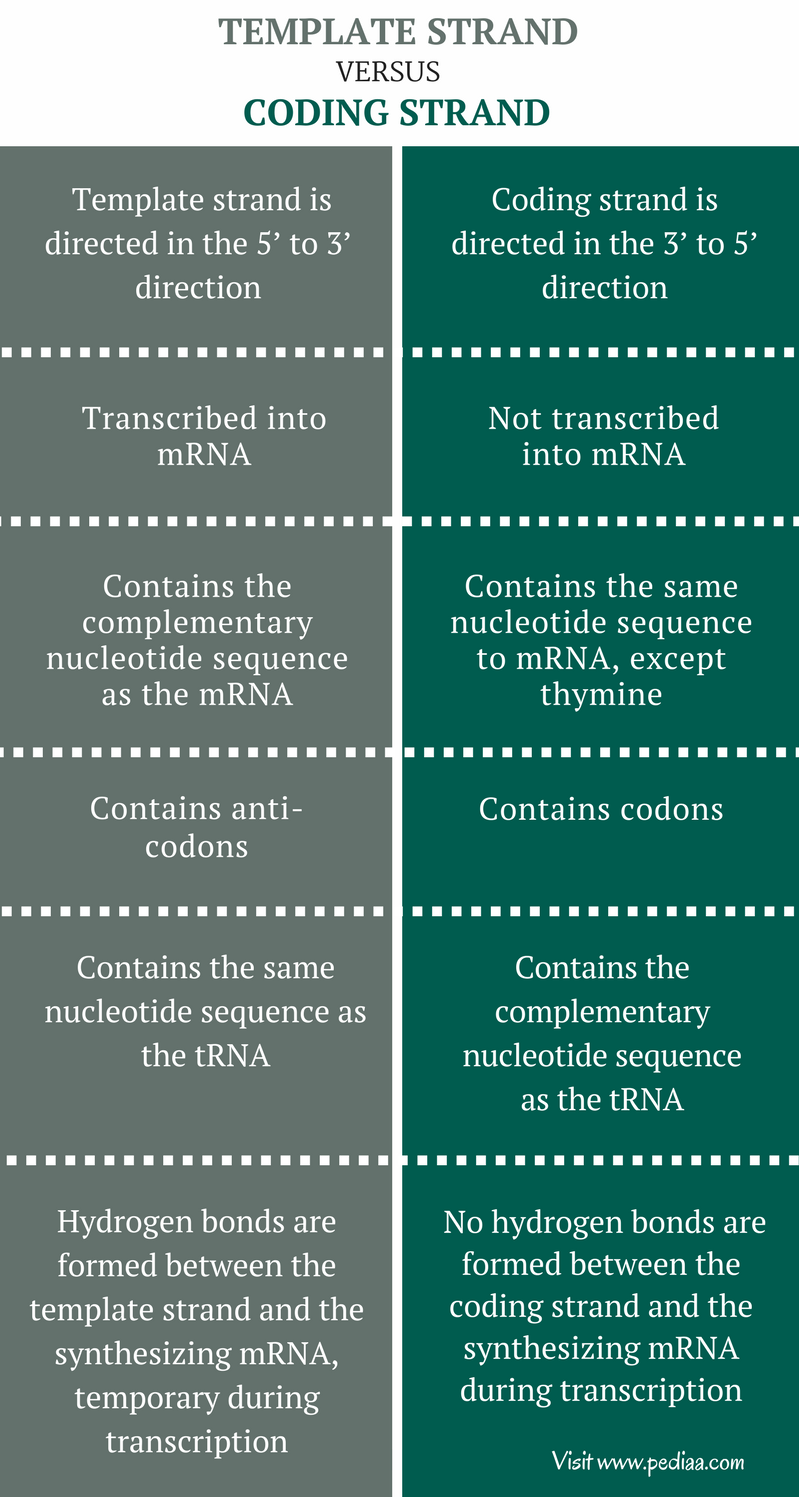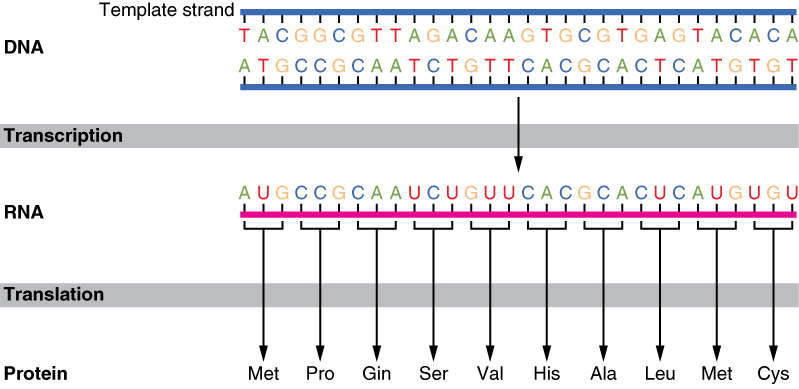Which Is The Template Strand And Which Is The Coding Strand
Main Difference – Template vs Coding Strand
Template and coding strand are the two terms that depict the two strands in the double-stranded DNA. During transcription, one of the 2 strands in the double-stranded DNA serves equally the template strand. The template strand runs in 3' to 5' direction. The other strand in double-stranded DNA, which runs from 5' to 3' direction is known as the coding strand. The template strand is responsible for the amino acid sequence in synthesizing the polypeptide chain. The chief deviation between template and coding strand is that template strand only serves as the template for transcription whereas coding strand contains the verbal same sequence of nucleotides in the mRNA except thymine.
This article looks at,
ane. What is Template Strand
– Definition, Characteristics, Construction
two. What is Coding Strand
– Definition, Characteristics, Structure
three. What is the difference betwixt Template and Coding Strand

What is Template Strand
The template strand is the strand which serves equally the template for the mRNA synthesis during transcription. Unremarkably, RNA polymerase, which is the enzyme involved in the transcription of genes into mRNAs, adds nucleotides in the five' to 3' direction to the growing strand of mRNA. Therefore, the template strand should be directed from 3' to 5' in order to add complementary nucleotides to the growing mRNA strand in the v' to 3' direction. Hence, the Deoxyribonucleic acid strand, which consists of iii' to five' directionality in the double-stranded Dna, may serve equally the template strand in transcription. That means, the template strand is the DNA strand in the double-stranded Deoxyribonucleic acid which is responsible for the amino acid sequence of the synthesized polynucleotide chain. The other Deoxyribonucleic acid strand in the double-stranded DNA is called non-template. The template strand is too called the antisense strand or the positive strand.
The template strand consists of a sequence of anti-codons which are the nucleotide triplets found in the tRNAs individually. The anti-codon is complementary to codons in the non-template or the coding strand. The synthesizing mRNA is temporally attached to the template strand by forming hydrogen bonds with the complementary nucleotides in the template strand. RNA polymerase adds uracil as the complementary nucleotide to the mRNA strand for adenine in the template strand instead of thymine. The template strand in the transcription is shown in figure 1.

Figure one: Template Strand
What is Coding Strand
The Deoxyribonucleic acid strand which serves equally the non-template strand during transcription is referred to as the coding strand. Transcription is elongated in the v' to iii' direction by calculation complementary nucleotides to the mRNA strand. The coding strand also runs from 5' to 3' direction. Hence, coding strand is incapable of serving as the template during transcription. The coding strand contains codons, which are the nucleotide triplets which specify a unique amino acid in the polypeptide chain. These codons collectively brand the genetic code, which is a universal feature in nearly all the living forms on the world. Coding strand during the transcription is shown in figure ii.

Effigy 2: Coding Strand in the Transcription
The coding strand contains the aforementioned nucleotide sequence of the mRNA principal transcript. Therefore, bioinformatic tools like Blink and GeneMark, which are involved in the finding of genes in a particular DNA sequence, depending on the coding sequence in order to predict genes in that item Dna sequence. Since the coding strand contains similar sequences to the mRNA, the unique sequences in the mRNA-like start codon, stop codon and the open reading frame can exist found in the coding sequence. These features, along with the sequences of the promoter, tin can be used by bioinformatics tools to predict genes past Ab initio method.
Difference Between Template and Coding Strand
Names
Template Strand: Template strand is as well known as antisense strand, non-coding strand or negative strand.
Coding Strand: Coding strand is also known as either sense strand, non-template strand or positive strand.
Direction
Template Strand: Template strand is directed in the 5' to 3' direction.
Coding Strand: Coding strand is directed in the three' to v' management.
Transcription
Template Strand: Template strand is transcribed into mRNA.
Coding Strand: Coding strand is not transcribed into mRNA.
Messenger RNA
Template Strand: Template strand contains the complementary nucleotide sequence as the mRNA.
Coding Strand: Coding strand contains the same nucleotide sequence to mRNA, except thymine.
Codon/Anticodon
Template Strand: Template strand contains anti-codons.
Coding Strand: Coding strand contains the codons.
Hydrogen Bonding
Template Strand: Hydrogen bonds are formed between the template strand and the synthesizing mRNA, temporary during transcription.
Coding Strand: No hydrogen bonds are formed between the coding strand and the synthesizing mRNA during transcription.
Transfer RNA
Template Strand: Template strand contains the aforementioned nucleotide sequence equally the tRNA.
Coding Strand: Coding strand contains the complementary nucleotide sequence equally the tRNA.
Conclusion
The double-stranded Dna molecule is equanimous of two DNA strands, which are called template strand and coding strand. The template strand serves as the Dna template for transcription, which is the showtime step of cistron expression. RNA polymerase adds complementary nucleotides to the nucleotides that are encoded in the template strand in order to class the primary RNA transcript. The add-on of nucleotides occurs in the 5' to 3' direction. Hence, the directionality of the template strand should be 3' to 5'. The not-template Dna strand, which runs in the 5' to 3' management is referred to every bit the coding strand since information technology contains the same nucleotide sequence in the mRNA strand. Therefore, the main departure between template and coding strand is their ability to be transcribed past RNA polymerases.
Reference:
i. Alberts, Bruce. "From Deoxyribonucleic acid to RNA." Molecular Biology of the Cell. fourth edition. U.South. National Library of Medicine, 01 January. 1970. Web. 23 Mar. 2017.
ii. "Sense (molecular biology)." Wikipedia. Wikimedia Foundation, 22 Mar. 2017. Spider web. 23 Mar. 2017.
Image Courtesy:
1. "0324 DNA Translation and Codons" By OpenStax – (CC BY four.0) via Commons Wikimedia
2. "Simple transcription elongation1" By Forluvoft – Own work (Public Domain) via Commons Wikimedia

Which Is The Template Strand And Which Is The Coding Strand,
Source: https://pediaa.com/difference-between-template-and-coding-strand/
Posted by: hillwashis.blogspot.com


0 Response to "Which Is The Template Strand And Which Is The Coding Strand"
Post a Comment